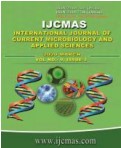


 National Academy of Agricultural Sciences (NAAS)
National Academy of Agricultural Sciences (NAAS)

|
PRINT ISSN : 2319-7692
Online ISSN : 2319-7706 Issues : 12 per year Publisher : Excellent Publishers Email : editorijcmas@gmail.com / submit@ijcmas.com Editor-in-chief: Dr.M.Prakash Index Copernicus ICV 2018: 95.39 NAAS RATING 2020: 5.38 |
The present investigation was studied to evaluate the synergistic effect of Rhizobium and rhizobacteria consortium for improving growth, symbiotic efficiency, soil quality and yield in summer mungbean under field conditions during summer season 2015. Mungbean seeds of two varieties (SML668 and SML832) were inoculated with Rhizobium (M1, LSMR1 and LSMR2) singly and in combination with rhizobacteria (LSRB1, LSRB2 and LSRB3). Significantly high dry weight of shoot (4.22 and 5.29 g plant-1) dry weight of root (0.411 and 0.604g plant-1) total nitrogen (1.59 and 1.52%) and phosphorus content (0.109 and 0.129 %) of shoot were recorded with consortium of native Rhizobium sp. (LSMR1) and rhizobacteria (LSRB3) in SML668 and SML832 varieties, respectively as compared to Rhizobium sp. alone as well as un-inoculated control. On the basis of overall mean, symbiotic and soil quality parameters were significantly high viz. dry weight of nodules (105.3 mg), leghaemoglobin content (2.61 mg/g of nodules), nitrate reductase activity of nodules (13.86 µmNO-2/hr/g of fresh nodules) and dehydrogenase activity (200 µg TPF/g/soil/hr) with LSMR1+LSRB3 treatment as compared to Rhizobium sp. alone as well as un-inoculated control. On an average, consortium of LSMR1+LSRB3 significantly improved the grain yield by 5.7% over Rhizobium sp. (LSMR1) and 9.2% over uninoculated control. Therefore present studies conclude that consortium of native Rhizobium sp. and rhizobacteria can be developed as a single delivery system biofertilizer for improving summer mungbean productivity.
 |
 |
 |
 |
 |